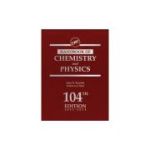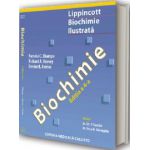CRC Handbook of Chemistry and Physics

DESCRIERE
High Quality Science requires High Quality Data! Today, more than ever, the CRC Handbook of Chemistry and Physics is critical in ensuring that researchers, educators, and students have the highest quality data for chemical compounds and physical particles. Available both in print and online, the Handbook covers 390 chemistry, physics, and related subjects organized in easy-to-find, well-organized tables. Every year, new reported data and new scientific areas are added, making the Handbook the largest comprehensive physical science data source available anywhere.
The 104th Edition of the Handbook has been completely reorganized to meet the needs of today’s scientists. The first section has property data on the elements, organic and inorganic compounds, water, bio-medical compounds, and polymers. Other sections focus on applications of chemical and physical data, data of importance in laboratory work, and information of units and nomenclature. The purpose of the reorganization is to make sure users can easily find all data on related subjects.
Handbook features include:
- All data reviewed and evaluated by subject matter experts
- Standardized chemical names, structures, property names, and property units
- Important information on subjects such as chemical and laboratory safety, and nomenclature
- Chemical and physical data critical for fields such as environmental science, bio-medical chemistry, organic and inorganic chemistry, materials innovation, geo- and astrophysics, and solid-state science
- Digital tools in our Online Edition to analyze, graph, process, and exploit our data content
Introduction
The Editor and Editorial Board
Preface
New Data and Updates in the 104th Edition
On the Evaluation of Chemistry and Physics Data
Current Contributors
Part 1 Data on Chemical Substances
Section 1: Elements and Their Isotopes
Introduction
The Elements
Standard Atomic Weights
Atomic Masses and Isotopic Abundances
Abundance of Elements in the Earth's Crust and in the Sea
Melting, Boiling, Triple, and Critical Points and Densities of the Elements
Heat Capacity of the Elements at 25 °C
Table of the Isotopes
Phase Transitions in the Solid Elements at Atmospheric Pressure
Crystal Structures and Lattice Parameters of Allotropes of the Elements
Density of Molten Elements as a Function of Temperature
Physical Properties of the Rare-Earth Metals
Thermal and Physical Properties of Pure Elemental Metals
Electrical Resistivity of Pure Elemental Metals
Electron Work Function of the Elements
Magnetic Susceptibility of the Elements
Optical Properties of Selected Elements
Index of Refraction of Liquid Elements
Vapor Pressure of the Metallic Elements - Equations
Vapor Pressure of the Metallic Elements - Data
Section 2: Atomic Structure and Spectroscopy Data
Introduction
Electron Configuration and Ionization Energy of Neutral Atoms in the Ground State
Ionization Energies of Atoms and Atomic Ions
Electron Affinities of the Atomic Elements
Persistent Lines of the Neutral Atomic Elements
Atomic Transition Probabilities
Atomic Radii of the Elements
Polarizabilities of the Atomic Elements
Section 3: Properties of Organic Compounds
Introduction
Physical Constants of Organic Compounds
CAS Registry Number Index of Organic Compounds
Diamagnetic Susceptibility of Selected Organic Compounds
Critical Constants of Organic Compounds
Dissociation Constants of Organic Acids and Bases
Miscibility of Organic Solvents
Dependence of Boiling Point of Organic Liquids on Pressure
Bond Lengths in Crystalline Organic Compounds
Bond Lengths in Organometallic Compounds
Section 4: Properties of Inorganic Compounds
Introduction
Physical Constants of Inorganic Compounds
CAS Registry Number Index of Inorganic Compounds
Critical Constants of Inorganic Compounds
Permittivity (Dielectric Constant) of Inorganic Solids
Density of Molten Inorganic Salts as a Function of Temperature
Dissociation Constants of Inorganic Acids and Bases
Index of Refraction of Inorganic Liquids
Index of Refraction of Inorganic Crystals
Magnetic Susceptibility of Selected Inorganic Compounds
Optical Properties of Selected Inorganic Solids and Teflon
Aqueous Solubility of Inorganic Compounds as a Function of Temperature
Solubility Product Constants of Inorganic Salts
Solubility Chart for Inorganic Salts
Solubility of Common Inorganic Salts as a Function of Temperature
Properties of Gas Clathrate Hydrates
Physical and Optical Properties of Minerals
Crystallographic Data on Minerals
Section 5: Properties of Water
Introduction
Thermophysical Properties of Water and Steam
Fixed-Point Thermophysical Properties of H2O and D2O
Properties of Saturated Liquid D2O
Vapor Pressure and Other Saturation Properties of Water
Standard Density of Water as a Function of Temperature
Ionization Constant of Water as a Function of Temperature and Pressure
Ionization Constant of Normal and Heavy Water at Saturated Vapor Pressure
Electrical Conductivity of Water
Permittivity (Dielectric Constant) of Water at Various Frequencies
Properties of Ice and Supercooled Water
Vapor Pressure of Ice
Melting Point of Ice as a Function of Pressure
Index of Refraction of Water
Section 6: Properties of Polymers
Introduction
Abbreviations Used in Polymer Science and Technology
Physical Properties of Selected Polymers
Solvents for Common Polymers
Glass Transition Temperatures for Selected Polymers
Dielectric Constant of Selected Polymers
Pressure-Volume-Temperature Relationships for Polymer Melts
Vapor Pressures (Solvent Activities) for Binary Polymer Solutions
Solubility Parameters of Selected Polymers
Section 7: Properties of Bio-Medical Compounds and Substances
Introduction
Properties of Amino Acids
Structures of Common Amino Acids
Properties of Purine and Pyrimidine Bases
The Genetic Code
Properties of Fatty Acids and Their Methyl Esters
Composition and Properties of Common Oils and Fats
Carbohydrate Names and Symbols
Standard Transformed Gibbs Energies of Formation for Biochemical Reactants
Apparent Equilibrium Constants for Enzyme-Catalyzed Reactions
Apparent Equilibrium Thermodynamics of Protein-Ligand Binding Reactions
Thermodynamic Quantities for the Ionization Reactions of Buffers in Water
Biological Buffers
Typical pH Values of Biological Materials and Foods
Properties and Functions of Common Drugs
Properties of Controlled Substances
Section 8: Chemical Structure, Bonding, and Molecular Spectroscopy Data
Introduction
Structure of Free Molecules in the Gas Phase
Characteristic Bond Lengths in Free Molecules
Dipole Moments
Hindered Internal Rotation
Bond Dissociation Energies
Electronegativity
Force Constants for Bond Stretching
Fundamental Vibrational Frequencies of Small Molecules
Spectroscopic Constants of Diatomic Molecules
Polarizabilities of Molecules
Ionization Energies of Gas-Phase Molecules
Electron Affinities of Molecules
Part 2 Data for the Practice of Chemistry and Physics
Section 9: Physical Chemistry Data
Introduction
CODATA Key Values for Thermodynamics
Standard Thermodynamic Properties of Chemical Substances
Thermodynamic Properties as a Function of Temperature
Thermodynamic Properties of Aqueous Ions
Proton Affinities
Heat of Combustion
Heat Capacity of Selected Solids
Electrical Conductivity of Aqueous Solutions
Molar Electrical Conductivity of Aqueous HF, HCl, HBr, and HI
Molar Electrical Conductivity of Electrolytes in Aqueous Solution
Ionic Conductivity and Diffusion at Infinite Dilution
Electrochemical Series
Activity Coefficients of Acids, Bases, and Salts
Mean Activity Coefficients of Electrolytes as a Function of Concentration
Enthalpy of Dilution of Acids
Enthalpy of Solution of Electrolytes
Concentrative Properties of Aqueous Solutions
Ebullioscopic Constants for Calculation of Boiling Point Elevation
Cryoscopic Constants for Calculation of Freezing Point Depression
Freezing Point Lowering by Electrolytes in Aqueous Solution
Azeotropic Data for Binary Mixtures
Section 10: Environmental Chemistry Data
Introduction
Chemical Reaction Rate Constants for Atmospheric Studies
Properties of Refrigerants
Global Warming Potential of Greenhouse Gases
Atmospheric Concentration of Carbon Dioxide, 1958-2022
Aqueous Solubility and Henry's Law Constants of Organic Compounds
Properties of Seawater
Solubility of Hydrocarbons in Seawater
Octanol-Water Partition Coefficients
Global Temperature Trend, 1880-2022
Solar Irradiance at the Earth
Geographical and Seasonal Variations in Solar Radiation
Infrared Absorption by the Earth's Atmosphere
U.S. Standard Atmosphere (1976)
Section 11: Solid-State Chemistry and Physics Data
Introduction
Techniques for Materials Characterization
Symmetry of Crystals
Ionic Radii in Crystals
The Madelung Constant and Crystal Lattice Energy
Elastic Constants of Single Crystals
Polarizability of Atoms and Ions in Solids
Electrical Resistivity of Binary Alloys
Electrical Resistivity of Graphite Materials
Curie Temperature of Selected Ferroelectric Crystals
Properties of Antiferroelectric Crystals
Properties of Superconductors
High-Temperature Superconductors
Organic Superconductors
Properties of Semiconductors
Selected Properties of Semiconductor Solid Solutions
Properties of Organic Semiconductors
Diffusion Data for Semiconductors
Properties of Magnetic Materials
Organic Magnets
Properties of Selected Materials at Cryogenic Temperatures
Thermoelectric Properties of Metals and Semiconductors
Thermal Conductivity of Metals and Semiconductors as a Function of Temperature
Fermi Energy and Related Properties of Metals
Secondary Electron Emission
Electron Inelastic Mean Free Paths
Electron Stopping Powers
Attenuation Coefficients for High-Energy Electromagnetic Radiation
Thermal Conductivity of Crystalline Dielectrics
Thermal Conductivity of Ceramics and Other Insulating Materials
Section 12: Industrial Chemistry Data
Introduction
Thermophysical Properties of Air
Thermophysical Properties of Fluids
Thermophysical Properties of Selected Fluids at Saturation
Vapor Pressure of Compounds and Elements
Vapor Pressure of Fluids at Temperatures below 300 K
Vapor Pressure of Saturated Salt Solutions
Enthalpy of Vaporization
Enthalpy of Fusion
Virial Coefficients of Selected Gases
Compressibility and Expansion Coefficients of Liquids
Temperature and Pressure Dependence of Liquid Density
Properties of Cryogenic Fluids
Properties of Liquid Helium
Properties of Ionic Liquids
Energy Content of Fuels
Surface Tension of Common Liquids
Surface Tension of Aqueous Mixtures
Surface Active Chemicals (Surfactants)
Permittivity (Dielectric Constant) of Liquids
Permittivity (Dielectric Constant) of Gases
Viscosity of Gases
Viscosity of Liquids
Thermal Conductivity of Gases and Refrigerants
Thermal Conductivity of Liquids
Influence of Pressure on Freezing Points
Sublimation Pressure of Solids
Solubility of Selected Gases in Water
Solubility of Carbon Dioxide in Water at Various Temperatures and Pressures
Solubility of Organic Compounds in Pressurized Hot Water
Diffusion in Gases
Diffusion of Gases in Water
Diffusion Coefficients in Liquids at Infinite Dilution
Mean Free Path and Related Properties of Gases
Index of Refraction of Air
Index of Refraction of Gases
Index of Refraction of Liquids for Calibration Purposes
Section 13: Astrophysics, Earth Sciences, and Physics Data
Introduction
Astronomical Constants
Properties of the Solar System
Interstellar Molecules
Mass, Dimensions, and Other Parameters of the Earth
Density, Pressure, and Gravity as a Function of Depth within the Earth
Acceleration Due to Gravity
Ocean Pressure as a Function of Depth and Latitude
Summary Tables of Particle Properties
Blackbody Radiation
Classification of Electromagnetic Radiation
Part 3 Data for Modern Chemical Laboratories
Section 14: Analytical Chemistry Data
Introduction
Abbreviations and Symbols Used in Analytical Chemistry
Basic Instrumental Techniques of Analytical Chemistry
Analytical Standardization and Calibration
Figures of Merit
Mass- and Volume-Based Concentration Units
Detection of Outliers in Measurements
Properties of Carrier Gases for Gas Chromatography
Common Symbols Used in Gas and Liquid Chromatographic Schematic Diagrams
Standard Fittings for Compressed Gas Cylinders
Stationary Phases for Porous-Layer Open Tubular Columns
Coolants for Cryotrapping
Properties of Common Cross-Linked Silicone Stationary Phases
Detectors for Gas Chromatography
Varieties of Hyphenated Gas Chromatography with Mass Spectrometry
Gas Chromatographic Retention Indices
Pressure Drop in Open Tubular Gas Chromatographic Columns
Phase Ratios for Capillary Columns
Minimum Recommended Injector Split Ratios for Capillary Columns
Eluotropic Values of Solvents on Octadecylsilane and Octylsilane
Solid-Phase Micro-extraction Sorbents
Instability of HPLC Solvents
Fluorescence Labeling Reagents Used Pre-Column in HPLC
Detectors for Liquid Chromatography
Solvents for Ultraviolet Spectrophotometry
Correlation Table for Ultraviolet Active Functionalities
Middle-Range Infrared Absorption Correlation Charts
Common Spurious Infrared Absorption Bands
Raman Band Frequencies
Nuclear Spins, Moments, and Other Data Related to NMR Spectroscopy
Properties of Important NMR Nuclei
Proton NMR Absorption of Major Chemical Families
Proton NMR Correlation Chart for Major Organic Functional Groups
Proton NMR Shifts of Common Organic Liquids
Proton Chemical Shifts of Contaminants in Deuterated Solvents
13C-NMR Absorptions of Major Functional Groups
13C-NMR Chemical Shifts of Common Organic Solvents
15N-NMR Chemical Shifts of Major Chemical Families
Natural Abundance of Isotopes Important in Mass Spectrometry
Common Mass Spectral Fragmentation Patterns of Organic Compound Families
Common Mass Spectral Fragments Lost
Major Reference Masses in the Spectrum of Heptacosafluorotributylamine (Perfluorotributylamine)
Mass Spectral Peaks of Common Organic Liquids
Common Spurious Signals Observed in Mass Spectrometers
Chlorine-Bromine Combination Isotope Intensities in Mass Spectral Patterns
Standards for Laboratory Weights
Reduction of Weighings in Air to Vacuo
Indicators for Acids and Bases
Preparation of Special Analytical Reagents
Organic Analytical Reagents for the Determination of Inorganic Ions
Section 15: Chemical and Laboratory Safety Data
Introduction
Chemical Safety
Abbreviations Used in the Assessment and Presentation of Laboratory Hazards
Incompatible Chemicals
Explosion (Shock) Hazards
Water-Reactive Chemicals
Testing Requirements for Peroxidizable Compounds
Tests for the Presence of Peroxides
Pyrophoric Compounds - Compounds That Are Reactive with Air
Flammability of Common Solvents and Other Chemical Substances
Types and Uses of Fire Extinguishers
Materials Compatible with and Resistant to 72 Percent Perchloric Acid
Selection of Laboratory Gloves
Selection of Protective Laboratory Garments
Selection of Respirator Cartridges and Filters
Protective Clothing Levels
Selection of Hearing Protection Devices
Chemical Fume Hoods and Biological Safety Cabinets
Gas Cylinder Safety and Stamped Markings
Compressed Air Safety
Safety in the Use of Cryogens
Plug and Outlet Configurations for Common Laboratory Devices
Electrical Shock Hazards
Ladder Safety in Laboratories
Magnetic Field Safety
Nanomaterial Safety Guidelines
Threshold Limits for Airborne Contaminants
Chemical Carcinogens
Laser Hazards in the Laboratory
General Characteristics of Ionizing Radiation for Practical Application of Radiation Protection
Radiation Safety Units
Relative Dose Ranges from Ionizing Radiation
Annual Limits on Intakes of Radionuclides
Section 16: Practical Laboratory Data
Introduction
Laboratory Solvents and Other Liquid Reagents
Density of Solvents as a Function of Temperature
pH Scale for Aqueous Solutions
Buffer Solutions Giving Round Values of pH at 25 °C
Constant Humidity Solutions
Standard Salt Solutions for Humidity Calibration
Low-Temperature Baths for Maintaining Constant Temperature
Metals and Alloys with Low-Melting Temperature
Standard KCl Solutions for Calibrating Electrical Conductivity Cells
Characteristics of Particles and Particle Dispersoids
International Temperature Scale of 1990 (ITS-90)
Reference Points on the ITS-90 Temperature Scale
Standard ITS-90 Thermocouple Tables
Part 4 Reference Tables and Indices
Section 17: Units, Constants, and Conversion Factors
CODATA Recommended Values of the Fundamental Physical Constants: 2018
International System of Units (SI)
Expression of Uncertainty of Measurements
Descriptive Terms for Solubility
Units for Magnetic Properties
Conversion Factors for Energy Units
Conversion Factors for Pressure Units
Units of Measure for Vacuum Systems
Values of the Gas Constant in Different Unit Systems
Conversion Factors for Thermal Conductivity Units
Section 18: Nomenclature, Terminology, and Symbols
Nomenclature for Chemical Compounds
Representation of Chemical Structures with the IUPAC International Chemical Identifier (InChI)
Definition of Ambient
Symbols and Terminology for Physical and Chemical Quantities
Scientific Abbreviations, Acronyms, and Symbols
Thermodynamic Functions and Relations
Section 19: Covers and Indices
Periodic Table of the Elements
Standard Atomic Weights in Atomic Order Number
Fundamental Physical Constants - Frequently Used Constants
Categorii de carte
-Comandă specială
-Edituri
-Promo
-Publicaţii Callisto
-Cărţi noi
-- 670,95 leiPRP: 745,50 lei
- 226,80 leiPRP: 252,00 lei
- 463,05 leiPRP: 514,50 lei
Promoţii
-- 144,38 leiPRP: 262,50 lei
- 207,90 leiPRP: 231,00 lei
- 1323,00 leiPRP: 1470,00 lei


















REVIEW-URI